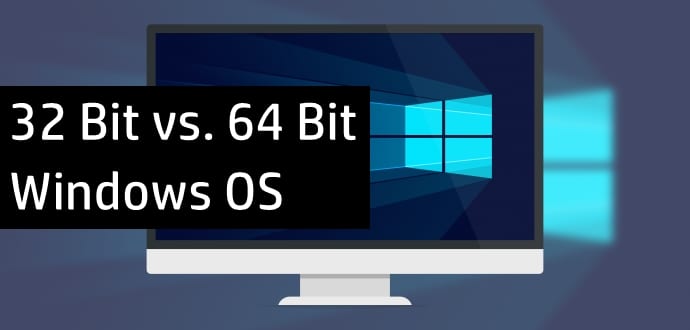Table Of Contents
What is 32-Bit Vs 64-Bit Windows operating system and which version should you choose?
32-Bit or 64-Bit! Which is the Windows version on my computer? This is the question most of you have when you are downloading an update or a new software. The issue came to head when Microsoft launched its new Windows 10 operating system and many of old Windows 7/8.1 users faced the conundrum of choosing the right version for their computers.
To understand the 32-bit and 64-bit let’s dig a little deeper. Every Microsoft Windows operating system from Windows XP to Windows 10 comes in two versions, 32-bit or a 64-bit version. But does it really matter? Nearly every PC nowadays has a 64-bit processor now, so why should you care about the difference between 32-bit and 64-bit operating systems?
32-Bit Vs 64-Bit processor
Microsoft started releasing 64-bit versions with Windows XP, which had the longest product lifespan of around 14 years. However, the record of the first 64-bit operating system goes to UNICOS created by the supercomputer-maker Cray Inc. in 1985. After a decade, nearly all operating system makers including Apple OS X, Microsoft Windows, Sun Microsystem Solaris, and the most recent Google’s Android have ventured into 64-bit versions.
Basically, the 64-bit versions were developed to take advantage of the advancing technology in chip architecture. The operating system is designed to utilize a kind of processor architecture and named so accordingly. A 32-bit OS is designed to take advantage of the resources facilitated by a 32-bit processor (like Intel’s x86) and while a 64-bit version takes advantage of a 64-bit processor.
Now that we got the processors right, let’s now focus on what does 64-bit even mean? In the context of discussions about 32-bit and 64-bit personal computers the XX-bit format refers to the width of the computer’s internal CPU’s register.
The CPU’s register is a small amount of storage used by the CPU where the CPU keeps the data it needs to access the quickest in order for optimum computer performance. The bit designation refers to the width of the register, thus a 64-bit register can hold more data than a 32-bit register which in turn holds more than 16-bit and 8-bit registers. The more ample the space in the CPU’s register system the more it can handle, especially in terms of utilizing system memory. A CPU with a 32-bit register, for example, has a ceiling of 2.
This further influences the speed at which a computer respond to a user. A CPU with a 32-bit register, for example, has a ceiling of 232 addresses within the register and is thus limited to accessing 4GB of RAM.
In the case of 64-bit, the register can store 2^64 values that amount to 16EB (exabytes) of RAM. A grand figure when compared to 4 GB memory that could be accessed by its 32-bit older counterpart.
Imagine having 8GB RAM on your laptop and yet you may be facing time lag in starting of apps or booting sequence. The reason behind this lag is probably because you have a 32-bit processor and it is unable to utilise the full power of 8GB RAM. The difference is even more visible if you are using resource hungry programs like Adobe Creative Suite.
32-Bit Vs 64-Bit Windows operating system
Now that we have understood the difference between a 32-bit processor and a 64-bit one, let’s get back to Windows operating system. As mentioned earlier, Microsoft started to take advantage of the 64-bit processor technology with Windows XP and later operating systems.
The Windows 64-bit operating system versions are designed to support more RAM than the 32-bit ones. Heavy resource users like developers, gamers, and film editors can get a performance boost if they use a 64-bit version of Windows and pack a higher RAM.
The minimum amount of RAM required for a 64-bit OS is 2 GB in comparison to 32-bit Windows which requires 1 GB RAM. If you are only an Internet surfing, Microsoft Excel and Word using person, this should suffice you. But if you are into gaming, software, multitasking, you should pack a minimum 4GB RAM on a 64-bit Windows PC/laptop. On the top side, the Home edition of Windows 10 can deal with 128GB RAM whereas the Windows 10 Pro version can handle 2048GB RAM without any sweat.
Also remember, running a 32-bit Windows version on a 64-bit processor works just fine but you can expect performance lag. You have to install a 64-bit OS on your machine to take full advantage of the 64-bit CPU. Windows 64-bit version offers Kernel Patch Protection which prevents unsupported changes to the kernel of the Windows OS along with Data Execution Prevention at the hardware level. A digital signature for all the drivers is a must in order to prevent installation of modified drivers which may be used to inject malware on the machine.
Conclusion
64-bit is definitely better than 32-bit. If speed matters to you, go for 64-bit Windows version PC/laptop. Also, nowadays, most processors in the market are 64-bit ones so you may end up working on an ancient architecture if you go for a 32-bit processor and Windows version. 64-bit also offers enhanced security infrastructure to protect your PC/laptop from hackers. Price-wise there is hardly any difference between the two processor versions so make sure your next PC or lappy has a 64-bit processor and a 64-bit Windows 10 version.

